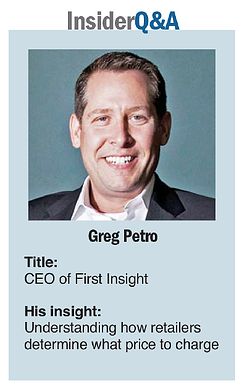|
 |
Figuring out what to sell and at what price is crucial for marketers of a consumer product, whether it's clothing
or makeup.
Pricing too low can cheapen the perception of the product, and pricing higher than what shoppers want to pay for it leads to lots of markdowns. Most retailers end up guessing or using historical data. Their collective mistakes result in a new product failure rate of more than 50 percent. That translates to more than $800 billion in annual losses due to excess inventory and missed opportunities, according to industry estimates.
Greg Petro founded the analytics firm First Insight in 2007 to help companies make informed decisions based on consumer feedback - well before the items hit the shelves.
First Insight plays online games with consumers designed to gather information about their preferences in pricing and design. A typical game shows a product's image and players are asked to answer multiple choice questions.
First Insight, which works with a diverse client list - which includes Abercrombie & Fitch, Avon and David's Bridal - guarantees a gross margin improvement anywhere from 3 percent to 9 percent.
How does your process work?
The First Insight solution predicts new product performance up to 18 months before these products hit the stores. This empowers product developers to make design changes early in the process to improve performance. It also lets designers and merchants know the price a new product will ultimately bear in the market, so they can forecast margins and possibly eliminate a product, which would otherwise need to be marked down.
It is fast and scalable: retailers get results in 24-72 hours and can test thousands of products per week. It is also fun, as we use online consumer games to collect input. Most importantly, it is accurate. We use predictive analytic models, which filter and weight the data. In a number of situations, our retail partners have doubled their number of winning products.
The system continues to learn and get smarter. Eleven percent of products we test could bear a higher price without slowing down the "velocity" or sell-through of the product (the percentage of a product that is actually sold). With one in 10 products being underpriced, this is an enormous missed opportunity.
What kind of insights have you learned?
We just ran our analytics on the next wave of wearable technology devices.
One interesting finding was that fitness wristbands are expected to do very well in the Midwest, indicating that a mainstream market may be developing. Also, we found that women are willing to pay more than men for most wearable tech devices. This can help a manufacturer or retailer focus its feature set and target its marketing toward the right audience.












